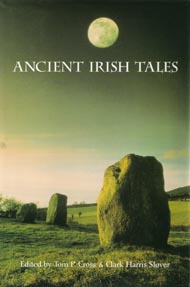Ancient Irish Tales
Edited by
Tom Peete Cross and Clark Harris Slover
Published by Barnes & Noble Books, 1936, 1996
The Tuatha De Danann lived in the northern isles of the world, learning lore and magic and druidism and wizardry and
cunning, until they surpassed the sages of the arts of heathendom. There were four cities in which they learned lore
and science and diabolic arts, to wit Falias and Gorias, Murias and Findias. Out of Falias was brought the Stone of Fal,
which was in Tara. It used to roar under every king that would take the realm of Ireland. Out of Gorias was brought
the Spear that Lug had. No battle was ever won against it or him who held it in his hand. Out of Findias was brought
the Sword of Nuada. When it was drawn from its deadly sheath, no one ever escaped from it, and it was irresistible.
Out of Murias was brought the Dagda's Cauldron. No company ever went from it unthankful. Four wizards (there were)
in those four cities. Morfesa was in Falias: Esras was in Gorias: Uscias was in Findas: Semias was in Murias.
Those are the four poets of whom the Tuatha De learnt lore and science."
- from Ancient Irish Tales
Readers of this comprehensive collection of epic and romantic literature can look forward to well-chosen examples
of the three main cycles of early-Irish literature, as well as to romances and sagas that don't fall into any of
the main cycles but are still rich in early-Irish tradition.
Found in the book's first part, titled Tales of the Tuatha De Danann, are stories that belong to the first -
the mythological - cycle. The Tuatha De Danann (people of the goddess Danu, or Anu) were learned in arts
and magic and are depicted as strong and beautiful beings - not quite gods, but not ordinary mortals either.
Believed to have come to Ireland from the north of Europe, they lived in a district along the river Boyne near
Stackallen Bridge and in the fairy mound of Femin in Tipperary.
Part two, called the Ulster Cycle, consists of sagas and tales that deal with the traditional heroes of what is now eastern
Ulster. In these ancient sagas, readers will meet the powerful Ulster king Conchobar and his band of chosen warriors,
which includes Fergus mac Roig, Bricriu of the Poison Tongue, Cathbad the druid; and, most famous of all, the
youthful Cu Chulainn, the subject of some of Ireland's finest heroic tales. A highlight of the Ulster stories
are the many references to ancient manners and customs.
The Finn cycle of tales comprises the book's third part. Irish annals provide numerous tales of Finn,
and though they differ greatly in their conceptions of him, all regard him as the chief of a warrior band
whose heroes include his son (Ossian) and grandson (Oscar). This lively section will make it clear why the
exploits of Finn and his companions have formed a part of the popular culture of Gaelic-speaking Ireland
and Scotland for several centuries.
Also included in the volume are tales of the traditional kings (with one about the king of the Lepracans
and another about royal gluttony, among others); the story of the voyage of Bran son of Febal; and
place-name stories.
(The text above comes from the back and inner flaps of the book)
Contents of this book:
Tales of the Tuatha De Danann
- The Book of Invasions
- The Second Battle of Mag Tured (Moytura)
- The Fate of the Children of Tuirenn
- The Wooing of Etain
- The Destruction of Da Derga's Hostel
The Ulster Cycle
- The Birth of Conchobar
- The Birth of Cu Chulainn
- The Boyhood Deeds of Cu Chulainn
- The Wooing of Emer
- The Tragic Death of Connla
- The Sick-Bed of Cu Chulainn
- The Story of Mac Datho's Pig
- The Debility of the Ulstermen
- The Catle-Raid of Regamna
- The Intoxication of the Ulstermen
- The Exile of the Sons of Usnech
- The Adventures of Nera
- Bricriu's Feast
- The Catle-Raid of Cooly
- The Tragic Death of Cu Roi Mac Dairi
- Death Tales of the Ulster Heroes
- The Phantom Chariot of Cu Chulainn
The Cycle of Finn, Ossian, and their companions
- The Cause of the Battle of Cnucha
- The Boyhood Deeds of Finn
- The Persuit of Diarmuid and Grainne
- The Hiding of the Hill of Howth
- The Death of Finn
- Oisin in the Land of Youth
- The Colloquy of the Old Men
Tales of the Traditional Kings
- The Death of Fergus Mac Leide
- The Adventures of Connla The Fair
- The Adventures of Art Son of Conn
- Cormac's Adventures in the Land of Promise
- The Adventures of the Sons of Eochaid Mugmedon
- The Death of Niall of the Nine Hostages
- The Death of Miurcertach Mac Erca
- The Wooing of Becfola
- How Ronan Slew His Son
- Stories of Mongan
- The Vision of Mac Conglinne
The Voyage of Bran Son of Febal
Place-Name Stories


